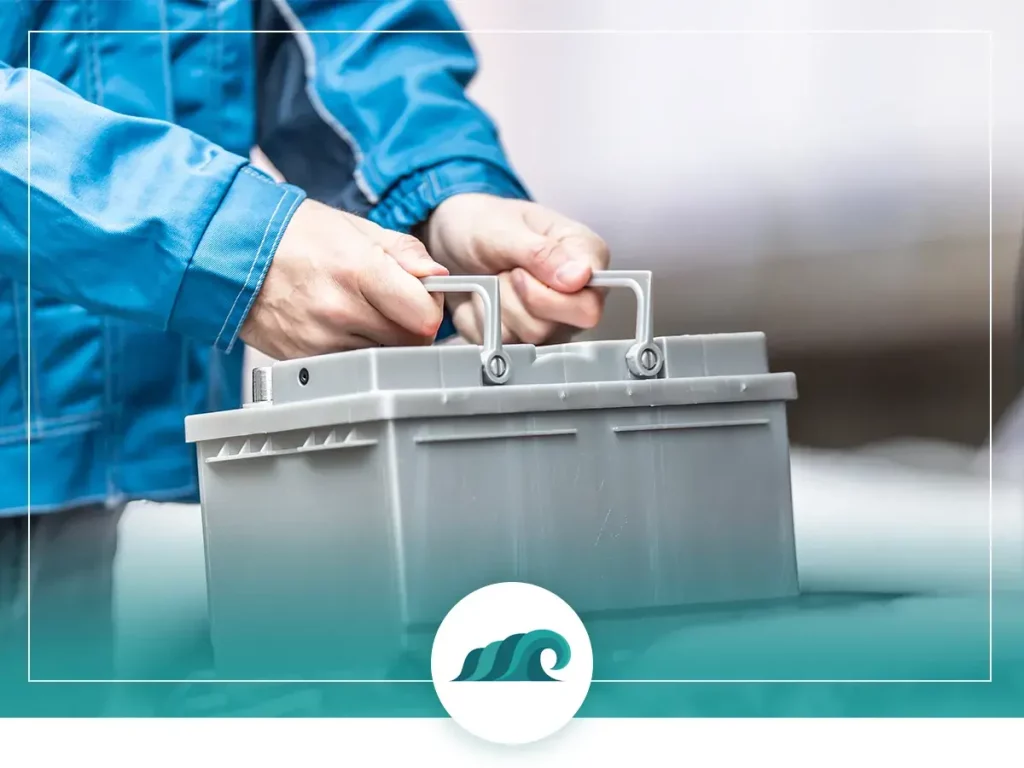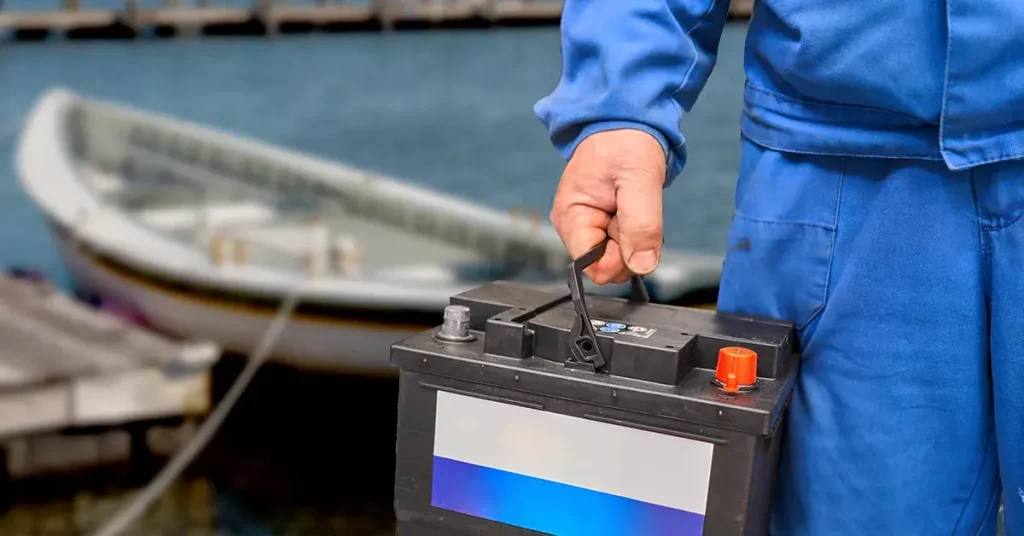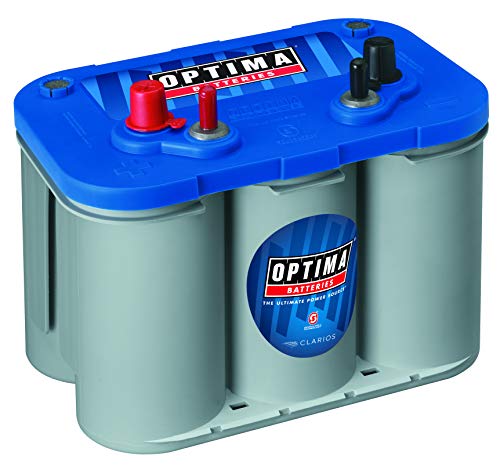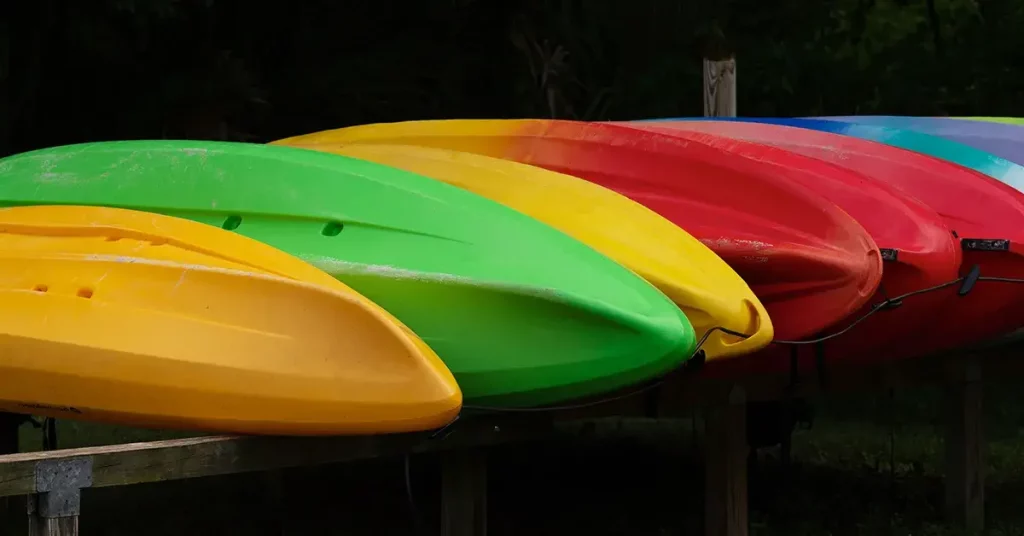While it might not be the most exciting piece of equipment on your watercraft, your trolling motor battery is key to the operation of your trolling motor, and should not be ignored. Marine batteries actually differ significantly in terms of performance and functionality, so it makes sense to get one that won’t let you down when you need it most.
If you’re not that familiar with marine battery technology – you’ll be happy to know they’ve come a long way in recent years. Whereas marine batteries used to be limited to finnicky lead acid models, modern AGM batteries are fully sealed and require little to no maintenance – so you’ll have one less thing to worry about on your boat.
Picking the right trolling motor battery for your craft and needs can seem a little tricky and technical, so I’ll attempt to break it down as simply as possible. Let’s take a look at some of the key features to be aware of when choosing a marine battery.
Quick Answer: 7 Best Trolling Motor Batteries
- Best Overall: Odyssey 31M-PC2150ST-M Trolling Thunder
- Best High Capacity: VMAX MR137-120 AGM
- Best Medium Sized Battery: Weize 12V 55AH Deep Cycle Battery
- Best for Smaller Craft: VMAX V35-857 AGM
- Best Dual Purpose: Optima Batteries 8016-103 D34M BlueTop
- Lithium Ion: Battle Born LiFePO4 Deep Cycle Battery 100 Ah
- Budget Pick: Mighty Max ML35-12 35 Ah
Types of Trolling Motor Batteries

There are a number of different types of trolling motor batteries commonly used.
Liquid Acid
Liquid acid batteries – also called wet-cell batteries – are designed to be charged and drained frequently. These batteries use an electrolyte (typically distilled water) to flood the lead plates, so they require more maintenance. They’re also a lot heavier than newer battery types.
Liquid acid batteries are not completely sealed, so they have the potential to leak battery acid and corrode if you’re not careful. Due to their finicky nature, they have a shorter shelf life than AGM batteries.
Also, due to their non-sealed design, they can’t be shipped in the mail, so these batteries have to be picked up in store.
AGM Batteries
Modern AGM (Absorbed Glass Mat) batteries are completely sealed, and won’t leak battery acid or require topping up with water. They’re super low maintenance, don’t require special vented housing, and can be left in your boat without worry about corrosion.
They also charge more rapidly than liquid acid batteries, and pound for pound provide more power, so they’re great for smaller craft like canoes, kayaks, and rafts. Their enclosed design also means you can install them in a variety of different positions on smaller craft.
When you’re talking about boats and trolling motors, vibration can be a major factor. AGM batteries perform far better with vibration than liquid acid units do – greatly increasing their utility.
They’ll perform well in cold temperatures, so you can use them year-round without any concern.
With all of these advantages, AGM batteries are generally the superior choice for most people. While they cost more than their Liquid Acid counterparts, the added functionality more than makeup for the cost. We’ll be focusing on these types in this article.
Lithium Ion
Lithium-ion batteries are the newest and most expensive battery type. These are the same type of batteries found in modern smartphones, laptops, and newer power tools. They’re extremely long-lasting, have impressively long shelf lives, work equally well in hot and cold weather, and weigh significantly less than other battery types.
The only downside to these batteries is cost. They can easily run $300+ per battery, so if you want top-shelf performance, you’ve got to be ready to shell out a few extra bucks.
Deep Cycle vs. Dual Purpose vs. Starting
Not all marine batteries are created equal. Batteries differ greatly in terms of functionality and intended use.
Starting batteries are built to discharge a high level of power in one go – which is what you need to turn over and start a large engine. These batteries aren’t suited for use with trolling motors, as they aren’t designed for a slow gradual discharge.
Dual-purpose batteries are designed with two purposes in mind. They can be used to start up engines as well as to provide a steady supply of power to trolling motors, electric downriggers, and other boat electronics. While they can perform both tasks reasonably well, they’re sort of a jack of all trades – decent at both but excelling at neither. If you’ve got a small craft with limited space to store a battery, then a dual-purpose battery makes a good option.
Deep Cycle Batteries are designed to provide a slow and steady power supply over a long period of time. These batteries are ideal for powering trolling motors and other boat electronics and will last far longer than dual-purpose batteries.
If you have a medium to large craft with enough room for more than one battery, going with a starting battery and a second deep cycle battery usually makes sense.
Amp Hours (Ah)
Marine batteries are typically rated in amp hours. Amp hours are a unit of electric charge, equal to the charge transferred by a steady current of one amp flowing for one hour. In short, a higher amp hour rating means it has a higher capacity to store electrical charge and will be able to power your motor and other electronics for longer.
Picking the right amp hour rating will depend on the amount of power required by your trolling motor. There is no “right” battery size, as your needs will differ depending on your boat’s weight, your motor size, and how much you use it.
Smaller batteries tend to be in the 25 Ah to 50 Ah range, while larger batteries are often 100+ Ah. For smaller vessels like kayaks and canoes, you’ll want to go with at least 25 Ah. For bass boats and other medium-sized craft, you’ll generally want to go with at least 75 Ah.
Keep in mind that batteries with a higher Ah rating will generally cost more than their smaller counterparts.
An easy way to calculate how long your battery will last is to divide the batteries’ Amp hours by the amp draw of your motor.
Group Size
Group size is an industry-standard for batteries that indicates the physical size of the battery. Its set by the BCI (Battery Council International). Generally speaking, the large the group size, the higher the amp hour capacity.
If you need a battery with a higher group size, consider the added size requirements. You may need a larger battery tray than the one you already have.
Best Overall: Odyssey 31M-PC2150ST-M Trolling Thunder
If you’re looking for one do-it-all battery that will perform exceptionally in a variety of conditions, the Odyssey Trolling Thunder is the one for you. It’s a dual-purpose battery that functions as both a sprinter and a long-distance runner, so it will work both as a cranking battery and as a deep cycle battery for powering your trolling motor and other boat electronics.
With a 100 Amp hour capacity and a reputation for a long-lasting life cycle, this battery is a cut above the competition. It operates up to 10 years long on average and features either a 3- or 4-year manufacturer’s warranty.
Excellent vibration resistance means you’ll never need to worry about damage from impact shock or motor vibration. It’s also been tested in a wide variety of temperatures (from -40° up to a 176° Fahrenheit), so you be confident it will work no matter how extreme the environment.
The AGM design means maintaining the battery is a breeze, with no level checking or maintenance required. Recharging is also extraordinarily fast, with a full recharge taking just 4 to 6 hours.
While it cost a fair bit more than single-purpose batteries, the added functionality, and extraordinary performance more than justify the added expense.
Key Features
- Group Size: 31
- Battery Type: Dual-purpose, AGM
- Capacity: 100 Ah
- Weight: 78 lbs.
- Dimensions: 13” x 6.80” x 9.41”
- Reserve Capacity: 205 minutes
- Cold Crank Amp (CCA)- 1150. Better warranty: Limited 3 and 4 year full replacement warranty: not pro rata; Longer service life: 3-10 years of service life: save consumers time, money and aggravation
- Longer cycle life: 70 percentage longer cycle life compared to conventional deep cycle batteries, up to 400 cycles at 80 percentage depth of discharge- high stable voltage for longer periods of time
- Recharge: Highest recharge efficiency of any sealed lead battery on the market, capable of 100 percentage recharge in 4-6 hours; Mounting flexibility: Non-spillable design
- Vibration resistance-design protects against high impact shock and mechanical vibration; Extreme temperature tolerant- Operating temperatures from -40 degree Celsius (-40 degree Fahrenheit) to 80 degree Celsius (176 degree Fahrenheit)
- This item is not for sale in Catalina Island
Prices pulled from the Amazon Product Advertising API on:
Product prices and availability are accurate as of the date/time indicated and are subject to change. Any price and availability information displayed on [relevant Amazon Site(s), as applicable] at the time of purchase will apply to the purchase of this product.
Best High Capacity: VMAX MR137-120 AGM
If you’re looking for a high capacity battery to run your trolling motor and other electronics, you’ll have a tough time beating this beast of a battery. It features an impressive 120 Amp hour capacity, providing enough juice to run your electronics all day long on the water.
The battery has an impressive life span of 8 to 10 years, and with heavy-duty lead-tin alloy grids it will provide consistent performance even after years of repeated discharges. It also performs well in extreme temperature environments, so you’ll have no worries using it when it gets frosty out there.
The battery weighs a hefty 75 pounds, making it heavier than smaller capacity batteries. Like other AGM batteries, its completely spill-proof and maintenance-free, so you can spend less time worrying about your battery and more time fishing!
Key Features
- Group Size: 31
- Battery Type: Deep Cycle, AGM
- Capacity: 120 Ah
- Weight: 75 lbs.
- Dimensions: 9″ x 6.8″ x 8.5″
- Reserve Capacity: 230 minutes
- 13*6.8*8.8h Heavy Duty 12V AGM DEEP CYCLE BATTERY with Float Service Life span of 8 to 10 years.
- Electrolyte Suspension system VMAX tanks utilize an electrolyte suspension system consisting AGM (Absorbed Glass Matt) of a high porosity that totally absorb and contain the electrolyte. No silica gels or any other contaminants are used.
- Heavy Duty Grids: VMAX heavy duty lead tin alloys provide an extra margin of performance and service life in either float or cyclic applications, even after repeated over discharge.
Prices pulled from the Amazon Product Advertising API on:
Product prices and availability are accurate as of the date/time indicated and are subject to change. Any price and availability information displayed on [relevant Amazon Site(s), as applicable] at the time of purchase will apply to the purchase of this product.
Best Medium Sized Battery: Weize 12V 55AH Deep Cycle Battery
Ideal for medium sized craft, this 55 Amp hour deep cycle battery from Weize is not only highly effective, it’s also priced fairly reasonably. It utilizes a state of the art, heavy-duty calcium alloy grid to provide long-lasting consistent performance on the water.
The AGM technology ensures no-spill performance and means it won’t require any maintenance once installed. The 55 Ah capacity provides enough juice to power a 30 lb thrust trolling motor for an entire day, so there’s no need to worry about running out of battery capacity.
A 1-year manufacturer’s warranty comes included with purchase, which is less than most high-end batteries. However, when you consider its lower price, the shortened warranty length makes sense.
Weighing just 36 pounds, it’s light enough to easily remove and swap between different craft, and measuring 9 x 9 x 5.4 inches, its small enough to fit in more compact craft like kayaks, canoes, and Jon boats.
Key Features
- Battery Type: Deep Cycle, AGM
- Capacity: 55 Ah
- Weight: 36 lbs.
- Dimensions: 9″ x 9″ x 5.4″
- TL1255/FP12550 is a Sealed Lead Acid Rechargeable Battery; Dimension: 9.02*5.43*9.06 inch. Parcel: 1x Battery (screws included, not included wire harness or mounting). TL1255 or FP12550 You Will Receive, Send Randomly,They Are the Same Quality,But Different production Batches.
- Used For Solar Panel Wind Energy Storage, Wheelchair, Mobile Scooter, Trolling Motor, Industrial and Medical Equipment, Electric Vehicles, Golf Carts, Hunting, Lawn and Garden Tools, Portable Tools, Toys and Hobby, Emergency Lighting, Leisure, RV House, Camping, Home Alarm Security and more.
- General Purpose for John Deere Lawn Tractor-Riding Mower 108, Bruno PWC 23002310 U1 Wheelchair, Pride Mobility Jazzy Select 6, MINNKOTA Trolling, ect.
- Power for Trolling Motor, Electric WheelChairs, Pride BATLIQ1018, Pride Mobility Jazzy 600/XL 614/HD, PowerCell PC12500 MK ES40 Powersonic Palmer Pride 600 Jazzy 1105 1107 1115 Jazzy 1100 1104 1120 2000 1170 1400 and more.
- Valve Regulated, Apill-Proof AGM Battery; With a 30 day refund policy. We aim for quality followed up with quality customer service, Amazon doesnt deal with the return of battery-related products, so please contact the seller directly. Weize support team is on standby for YOU
Prices pulled from the Amazon Product Advertising API on:
Product prices and availability are accurate as of the date/time indicated and are subject to change. Any price and availability information displayed on [relevant Amazon Site(s), as applicable] at the time of purchase will apply to the purchase of this product.
Best for Smaller Craft: VMAX V35-857 AGM
This compact battery is the perfect choice for smaller craft like kayaks, canoes, and inflatable rafts. Its designed for use with smaller trolling motors (18 to 40 lb thrust), and can power a 40 lb motor for approximately 4 hours on a single charge. Keep in mind that it can also be used with larger motors, but the lower capacity means you’ll run out of juice faster.
Like its larger counterpart reviewed above, the battery’s heavy-duty grids provide consistent and long-lasting performance even after repeated over discharges. The AGM design means there’s no need to check levels or perform any kind of maintenance on the battery.
The battery weighs a featherlight 25 pounds and measures just 7.7” x 5” x 6.1”, making it small enough to mount nearly anywhere in your craft. The spill-proof design also means you can mount it any way you like.
Key Features
- Group Size: U1
- Battery Type: Deep Cycle, AGM
- Capacity: 35 Ah
- Weight: 25 lbs.
- Dimensions: 7″ x 5″ x 6.1″
- Reserve Capacity: 75 minutes
- Dimensions: L=7.7 inch W=5 inch H=6.1 inch
- Heavy Duty Grids: VMAX heavy duty lead tin alloys provide an extra margin of performance and service life in either float or cyclic applications, even after repeated over discharges.
- Maintenance Free Operation: There is no need to check specific gravity of the electrolyte or add water to VMAX tanks during float service life. In fact, there is no provision for this type of maintenance.
Prices pulled from the Amazon Product Advertising API on:
Product prices and availability are accurate as of the date/time indicated and are subject to change. Any price and availability information displayed on [relevant Amazon Site(s), as applicable] at the time of purchase will apply to the purchase of this product.
Best Dual Purpose: Optima Batteries 8016-103 D34M BlueTop
If you’re looking for the cream of the crop marine battery that can do just about anything, the BlueTop from Optima is the battery for you. Striking design isn’t something that usually comes to mind when discussing marine batteries – but these batteries beg to differ! The distinctive blue top indicates the high capacity and extraordinary performance you can expect from these well-made AGM batteries.
Unlike most flat plate marine batteries, Optima batteries utilize individual spiral-wound cells comprising of two pure lead plates coated in lead oxide. This design makes each battery more energy-dense than the alternatives, delivers greater starting power, and greatly increases the vibration tolerance.
The design also makes it great for extreme temperatures and storing for long periods between charges. The low discharge rate means they’ll maintain a charge even after long periods of inactivity.
Don’t expect this battery to perform similarly to other 55 Amp-hour models, it provides far more efficiency and performance than a flat plate 55 Amp hour battery – hence the increased price. With 750 cold-cranking amps, it functions as both a cranking battery and a true deep cycle battery for sustained use.
Key Features
- Group Size: 34
- Battery Type: Dual-purpose, AGM
- Capacity: 55 Ah
- Weight: 44 lbs.
- Dimensions: 9″ x 10″ x 8″
- Reserve Capacity: 120 minutes
- 12-Volt, 750 Cold Cranking Amps, Size: 10 inches x 6 7/8 inches x 7 13/16 inches tall, Weight: 43.5 pounds, Dual SAE & 5/16 inches Stainless Steel Stud Posts. 55 Ah C20 capacity
- Optimal starting power even in bad weather
- Mountable in virtually any position. Works well as a boat battery or RV battery
- Fifteen times more resistant to vibration for durability
- Reserve capacity of 120 minutes for constant performance
- Cranking Amps - 870 Ampere / Marine Cranking Amps - 870 amp
Prices pulled from the Amazon Product Advertising API on:
Product prices and availability are accurate as of the date/time indicated and are subject to change. Any price and availability information displayed on [relevant Amazon Site(s), as applicable] at the time of purchase will apply to the purchase of this product.
Lithium Ion: Battle Born LiFePO4 Deep Cycle Battery 100 Ah
When it comes to marine batteries, lithium ion is unsurpassed in its capacity, weight, and life cycle. While these batteries certainly aren’t cheap, if you’re after the absolute cutting edge in battery technology, you can’t beat lithium ion.
Battle Born’s BMS (battery management system) is one of the best in the industry and does a phenomenal job of regulating temperature volatility and limiting power output when necessary to protect the li-ion cells. This system functions as the “brains” of the battery. Most people don’t realize this system is the most important feature of li-ion batteries – and can mean the difference between a battery lasting a decade and conking out after a year.
The battery recharges incredibly quickly and can be discharged to 90% regularly, whereas most AGM batteries have a recommended discharge 50% depth discharge. It also weighs a fraction of comparable lead acid or AGM batteries, at just 31 pounds!
The battery has an estimated life span of 3000 cycles, which is far greater than the 300 cycles typical for lead-acid batteries. Everything comes backed up with an industry-leading 10-year warranty – so you can be sure you’ll be covered in case anything goes wrong.
Key Features
- Battery Type: Deep Cycle, Lithium-ion
- Capacity: 100 Ah
- Weight: 31 lbs.
- Dimensions: 8″ x 6.9″ x 9″
- BUILT-IN BMS: BMS stands for Battery Management System - the brain of our deep cycle lithium batteries. Our BMS protects your battery from most common causes of battery failure, such as temperature volatility or ground faults. The BMS regulates the amount of power taken out of the battery and acts as a shut-off system to protect the li-ion cells (and you) from unsafe operating conditions.
- LITHIUM ION TECHNOLOGY: Unlike Lead Acid batteries, Battle Borns deep cycle lithium ion batteries have unlimited mounting capability, exceptional longevity, and are more cost effective. When factoring time and cost into your purchase, our lithium ion battery banks come out ahead every time. Plus, Li-Ion batteries can be safer than Lead Acid batteries, which have no protection against ground faults.
- GREEN ENERGY BATTERIES: Made from 100% safe, nontoxic, renewable energy, Battle Born Batteries last for more cycles and can be charged and discharged repeatedly (and charge faster than any other battery). We make our renewable, sustainable green energy batteries because they’re simply better than anything else out there, including other green batteries.
- LIGHTWEIGHT AND VERSATILE: At a sleek 31 lbs, our 100Ah 12v battery weighs in at only 1/3 the weight of lead acid batteries! With no acid in the battery, youre able to safely mount in any position. This makes li-ion batteries perfect for marine, RV, campers, golf cart, off-road and off-grid applications!
- *Please note, orders of six or more batteries will ship via freight and will require you to be able to accept a pallet shipment
Prices pulled from the Amazon Product Advertising API on:
Product prices and availability are accurate as of the date/time indicated and are subject to change. Any price and availability information displayed on [relevant Amazon Site(s), as applicable] at the time of purchase will apply to the purchase of this product.
Budget Pick: Mighty Max ML35-12 35 Ah
If you’re looking for a well-made, functional trolling motor battery without breaking the bank, then this light-duty battery is the one for you. It’s designed for use with smaller trolling motors in the 20 to 40 lb. thrust range, so don’t expect a single battery to power a full-sized motor for an extended period of time.
Like other AGM batteries its spill-proof and virtually maintenance-free, and can be mounted in a variety of positions (not upside down). Each battery weighs just 23 pounds and measures 7.7” x 5.1” x 7.1”, so you can easily remove and transport it if needed.
It’s also the cheapest battery reviewed here, so in addition to powering small watercraft, it makes a great secondary or backup battery for a larger boat. Mighty Max backs up the battery with a full one-year manufacturer’s warranty.
Key Features
- Group Size: U1
- Battery Type: Deep Cycle, AGM
- Capacity: 35 Ah
- Weight: 23 lbs.
- Dimensions: 7″ x 5.1″ x 7.1″
- ML35-12 SLA is a 12V 35AH Sealed Lead Acid (SLA) rechargeable maintenance free battery - UL Certified
- Dimensions: 7.76 inches x 5.12 inches x 7.01 inches. Listing is for the Battery and Screws only. No wire harness or mounting accessories included.
- SLA / AGM spill proof battery has a characteristic of high discharge rate, wide operating temperatures, long service life and deep discharge recover.
- Rechargeable battery that can be mounted in any position, resists shocks and vibration. Long lasting high performance in high and low temperatures.
- Backed by a 30 day refund policy and full 1 year warranty.
Prices pulled from the Amazon Product Advertising API on:
Product prices and availability are accurate as of the date/time indicated and are subject to change. Any price and availability information displayed on [relevant Amazon Site(s), as applicable] at the time of purchase will apply to the purchase of this product.
How to pick the right trolling motor battery

Picking out the right trolling motor battery for your needs can be a confusing task. Let’s take a look at some of the key factors to consider when picking out the right motor for your craft.
Trolling Motor Size
Perhaps the most important thing to consider when picking out a marine battery is your trolling motor’s power consumption. Pay particular attention to the amp draw of your trolling motor, as well as the power level you intend to use it at. Also, consider other boat electronics your planning to run as well.
As mentioned previously, you can make a quick calculation to determine how long a battery should last at whatever setting you plan to use it. Simply divide the battery’s Amp hour rating by the amp draw of your trolling motor and you’ve got a pretty good estimate of how long it will last on a single charge.
Reserve Capacity
Reserve capacity refers to the amount of time before a battery is discharged down to 10.5 volts when delivering 25 amps in an 80°F environment.
This might sound kind of arbitrary, but all you need to know is that a higher reserve capacity will keep your trolling motor running longer between charges. This measurement is useful for batteries that are regularly deep-cycled, so it’s not relevant for starter batteries.
Cold Cranking Amps
Cold cranking amps refers to the battery’s capability to deliver power in short bursts – such as when you’re starting an engine. If your battery is dual-purpose, both for cranking and deep cycling, then you should pay attention to this number.
A higher cold cranking amp number also indicates a greater ability to start an engine in cold temperatures, so if you fish in the fall and winter, pay particular attention.
If your battery is only going to be used for deep cycling, then this measurement is largely irrelevant.
Voltage
Most trolling motor batteries are 12 volt – which makes sense – as the vast majority of trolling motors are also 12 volt. Some high-end motors are 24 volt – so if you have one of these models, you’ll either need 2 x 12-volt batteries or a single 24-volt battery.
Weight
A battery’s weight generally has a direct correlation to its Amp hour capacity.
Larger, heavier batteries will provide enough juice to run a 55-pound thrust trolling motor from sun up to sun down without draining the charge. This means you’ll need to recharge less often, which will extend the lifetime of the battery.
Lighter batteries are ideal for running smaller trolling motors, as well as for smaller craft like kayaks, canoes, and dinghies. These batteries typically weigh less than 30 pounds, so they won’t have too much of an impact on your craft’s overall weight.
Warranty
When it comes to trolling motor batteries, good warranties are well worth seeking out. If you’ve owned a boat for a while, then you’ll probably know first-hand how these things can crap out unexpectedly.
Manufacturers differ significantly in the warranties they offer, with anything from one year up to 10 being fairly common. Make sure you take a look at what type of warranty the manufacturer offers, so you won’t end up with an expensive paperweight.
If you’re interested in learning how to wire trolling motor batteries, check out this in depth video:
Other Gear Needed
When you setting up your boat with trolling motor batteries, there are a few extra items that will greatly enhance your overall experience.
Charger: Firstly, a battery is only really as good as its charger. You don’t want to shell out a couple hundred bucks on a high-end battery, and then recharge it with a sub-par charger. This can cause damage to the battery and reduce its lifespan if done repeatedly. Always use the marine battery charger type recommended by the battery manufacturer.
Battery Box / Power Centre: While not strictly necessary, marine battery boxes or power centers are one of the best upgrades for kayaks, canoes, and small boats – and are worth every penny.
These boxes allow you to store your battery in a protective hard plastic shell that functions as a portable battery compartment. They often come with easy to read battery meters, external battery ports, built-in circuit breakers, and even USB charging ports for charging your cellphone and other devices.
FAQ’s
How long will trolling motor batteries last?
This will depend on the individual battery, how often you cycle it, as well as how you charge it and maintain it. Some anglers claim to get 5 to 10 years from a single AGM battery, but 3 to 5 years is more typical for a well-maintained AGM battery.
Things you can do to extend the life of your trolling motor battery: use the charger recommended by the manufacturer, don’t drain the battery down to 0% regularly, and don’t store the battery drained for long periods of time.
Do I need a deep cycle battery?
If you’re running a trolling motor, then you’ll need either a deep cycle battery or a dual-purpose battery.
Deep cycle batteries are designed to provide steady power over a prolonged period of time – such as running trolling motors, fishfinders, and other boat electronics. Dual-purpose batteries are designed to provide two functions – both to start a boat’s main motor and to deep cycle.
How to store trolling motor batteries?
Storing an AGM battery is pretty straightforward, all you need to do is charge the battery fully, clean off any signs of corrosion from the terminals, and store in a cool, dry environment. If you’re storing for several months, then you should hook the battery up to a battery minder/charger so it won’t lose capacity over time.
What size trolling motor batteries do I need?
This will depend on the size of your trolling motor, your craft, and how much battery capacity you need. You’ll generally want to match your battery size to the size of your craft.
Bass boats and other larger craft can go with a 75 to 100+ Amp hour battery. Kayaks, canoes and other small craft can go with a 35 to 55 Amp hour battery if they need to cut down on added weight and bulk.
Are AGM batteries better than wet cell batteries?
AGM batteries are longer-lasting, lower maintenance, and more durable than wet cell batteries. They do cost more though, so there is an inherent trade-off.


















